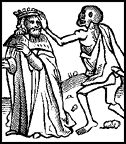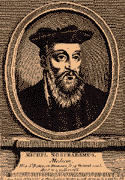 |
 |
 |
| |||||||||||||
|
|||

Michael Nostradamus (Michel de Nostredame or Nôtredame), b. Dec. 14, 1503, d. July 2, 1566, was a French physician and astrologer whose predictions of the future have fascinated people for centuries. Baptised a Christian to conceal his Jewish heritage during a period of violent anti-Semitism, Michel grew up in a lively, prosperous (his father Jacques was a notary) and warm household, full of conversation and the rich aromas of Provençal cooking. He was an enthusiastic and gifted student, with exceptional mathematical ability and a great love and mastery of astrology (known then as "celestial science"). His grandfathers Jean de Rémy and Pierre de Nostredame (both of them doctors) also noticed that Michel displayed a remarkable talent for prophecy at a very young age. They both taught him daily in a wide range of subjects, including classical literature, history, medicine, astrology, and herbal folk medicine. At the age of 14, Michel was sent to study in the city of Avignon, capital of the papal enclave in Provence. There he was taught philosophy, grammar and rhetoric by Catholic priests, but in his free time, he studied the occult and astrological books in the renowned papal library. As a result, he was nicknamed "the little astrologer", and his open defense of the astrologer Copernicus alarmed his family, who were afraid it might draw attention to them. Michel did have a traumatizing experience, witnessing his nanny being burned at the stake as an accused witch; perhaps that is one reason why he was to go to great lengths eluding the Inquisitors later in his life. 
Knowing that astrologers were generally more accepted if they were also accredited physicians, Michel's grandfather suggested a career in medicine. In 1522, Michel enrolled as a medical student at the University of Montpellier (founded in 1289). He became quickly dissatisfied with the ignorance and dogma of his professors, and was inclined toward following the research of François Rabelais at the University of Paris. Nostradamus acquired a great reputation as a doctor by treating victims of the bubonic plague (Le Charbon) which ravaged that part of Europe. His methodology contravened established medical practice of the period, since he opposed the traditional treatment of "bleeding" patients to rid them of disease, and his invention of an oral vitamin C supplement (rose pills) to enhance immune response in his patients met with considerable skepticism among his medical peers at the time. His views were considered to be heretical by the church, and he was persecuted on numerous occasions by the Inquisition, a body of clergy empowered to condemn victims accused of witchcraft and heresy. Michel's attentions turned once again to astrology and metaphysics. As his divining tool he employed a brass bowl, filled with water and perched on a tripod; his visions appeared to him reflected on the pool of water. An assistant described Nostradamus as descending from his study in a trance-like state following many of these visions. In 1555 he completed the Centuries, a book of more than 900 predictions about the fate of France, the world, and celebrated persons of his time. The title of the book refers to the fact that the contents are arranged in sections of 100 verses each. An expanded version was published in 1558. Nostradamus was consulted by Catherine de Medici — who shared his penchant for astrology — regarding the fate of her husband, King Henry II, as well as that of her three sons. His predictions that her husband would be killed in a joust, and that she would outlive each of her sons through their consecutive successions on the throne, were proved true. It was largely as a result of his protection by Catherine de Medici that Nostradamus was allowed to remain free to pursue his scientific studies and to publish his dire but accurate prophecies. 
The prophecies are written as four-lined rhymed verses (quatrains) in vague, often cryptic language. Nostradamus' fondness for anagrams and his penchant for sprinkling his verses with Hebrew, Latin, and Portuguese words further complicates interpretation of his predictions. Some interpreters say the verses can be applied to anything, or nothing, whereas others claim that various verses foretold the Great Fire of London in 1666, the invention of the guillotine, the deaths of several monarchs, details of the French Revolution, the rise of Napoleon and Hitler, World War II, submarine warfare, military incursions by helicopters and supersonic bombers, twentieth century earthquakes, nuclear holocausts, John F. Kennedy's assassination, man's landing on the moon, the advent of AIDS, and a host of other momentous events. Because Nostradamus included very few dates in his prophecies and because, additionally, he did not organize them into a chronological order, the verses have been constantly reinterpreted since the time of their publication. The Centuries remains a classic of occult literature; hundreds of studies of it have been published. An excellent film account of Nostradamus' life is available on Orion Home Video (©1994, 118 mins.), starring Tchéky Karyo in the title role, with F. Murray Abraham playing the part of his mentor, Dr. Scaliger (1), and Rutger Hauer as the Mystic Monk. (1) Julius-César Scaliger (1484-1558), Italian-born doctor of medicine who became a French citizen in 1528, settling in Agen. He wrote learned books on Latin grammar, philosophy and medicine.
Author: Ian C. Mills ©1998-2002 All Rights Reserved Bibliography: 1997 Grolier Multimedia Encyclopedia, v. 9.0.1. Wordsworth Dictionary of Biography, Helicon Publishing Ltd., Denmark. Nostradamus — the New Revelations, John Hogue, 1994, Element Inc., Rockport, MA. The Further Prophecies of Nostradamus — 1985 and Beyond, Erika Cheetham, 1985, Perigee Books, division of The Putnam Publishing Group, New York. Conversations with Nostradamus: His Prophesies Explained, 2 vols., rev. ed., Dolores Cannon, 1992, Ozark Mountain Publishers. Visionaries and Seers: They Saw Tomorrow, Charles Gattey, 1988, Prism Printing Ltd. Nostradamus: The End of the Millennium: Prophecies, 1992 to 2001, V. J. Hewitt and Peter Lorie, 1991 (out-of-print). Nostradamus and the Millennium, John Hogue, 1987 (reprinted May 1997 by HarperCollins). Nostradamus: An Illustrated Guide to His Predictions, Millie Ridge, 1993. The Comet of Nostrademus, R.W. Welch, 1996. Image sources: Cover shot of "The Complete Prophecies of Nostradamus": from Amazon.com Books. Timeline
|
||||||||||||||||||||||||||||||||||||

|
||||||||||